
views
Examining the Ankle

Recall the moment of injury. Try to remember what happened at the moment that you were injured. This may be difficult, especially if you are in a great deal of pain. However, your experience at the moment of injury may provide clues. How fast were you moving? If you were moving at a very high speed (e.g., skiing or running at top speed), there is a chance your injury is a bone fracture. This will require professional medical attention. A lower speed injury (e.g., rolling your ankle while jogging or walking) is more likely a sprain that may heal on its own with proper care. Did you feel a tearing sensation? In many cases you will, in the case of a sprain. Was there a popping or snapping sound? This can occur with a sprain. It is also common with a bone fracture.

Look for swelling. In the case of a sprain, your ankle will become swollen, usually immediately. Examine your ankles side-by-side to see if the injured one looks larger. Pain and swelling will usually occur in ankle sprain or fracture. Foot or ankle deformity and unbearable pain usually indicate ankle fractures. Make sure to use crutches and go to your doctor immediately.
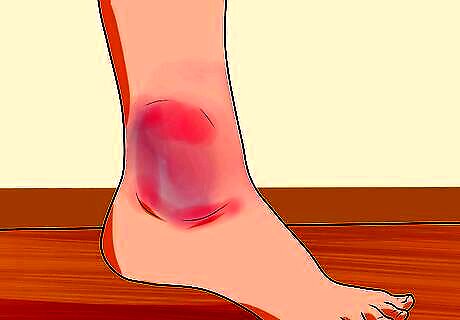
Look for bruising. A sprain also often causes bruising. Examine the ankle for signs of discoloration resulting from bruises.
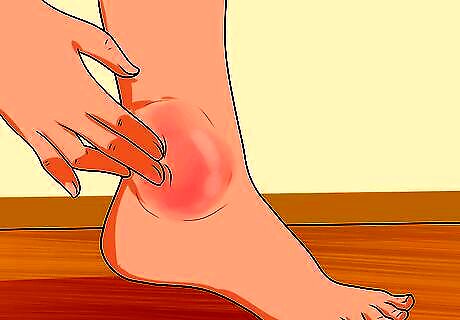
Feel for tenderness. A sprained ankle will often feel tender. Gently touch the injured area with your fingers to see if it is painful to the touch.
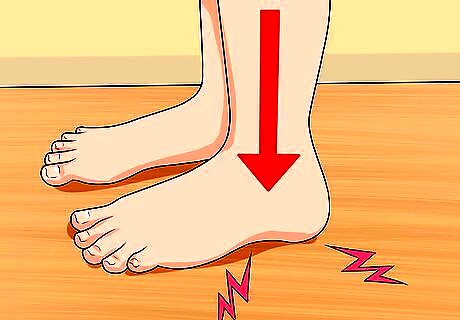
Put weight gently on the ankle. Stand up and gently put some weight on the injured ankle. If there is severe pain when you put weight on the ankle, it could be fractured. If you suspect it is fractured go to a doctor soon. Feel for a "wobbliness" in the ankle. A sprained ankle often feels loose or unstable. In the case of a severe sprain, you may not be able to put any weight on the ankle at all, or use that foot to stand. Doing so will cause too much pain. Use crutches and seek medical attention immediately.
Determining the Grade of a Sprain
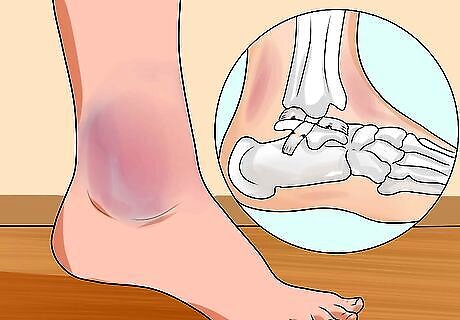
Recognize a grade I sprain. Ankle sprains come in three different grades. Treatment options will be determined based on the severity of the injury. The least severe is a grade I sprain. This is a minor tear that doesn't affect your ability to stand or walk. While it might be uncomfortable, you can still use your ankle normally. A grade I sprain may result in minor swelling and pain. In a minor sprain, swelling will usually go away in a few days. Self-care is usually enough for a minor sprain.
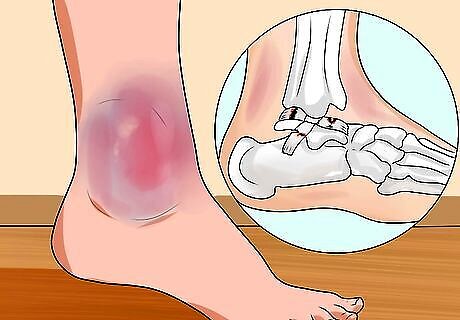
Recognize a grade II sprain. A grade II sprain is a moderate injury. It is an incomplete but substantial tear of a ligament or ligaments. In a grade II sprain, you will not be able to use your ankle normally and will have trouble putting weight on it. You will experience moderate pain, bruising, and swelling. The ankle will feel loose and may look as if it has been pulled forward somewhat. For a grade II sprain, you will need to use crutches and an ankle brace for a while to walk.
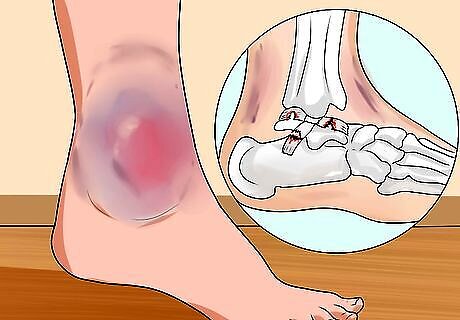
Recognize a grade III sprain. A grade III sprain is a complete tear and loss of the structural integrity of the ligament. With a grade III sprain, you will be unable to put any weight on the ankle and will be unable to stand without help. Pain and bruising will be severe. There will be significant swelling (more than 4 cm) around the fibula (calf bone). There may be notable foot and ankle deformity and high fibular fractures just below the knee, which can be determined by a medical examination. A grade III sprain requires the immediate attention of a doctor.
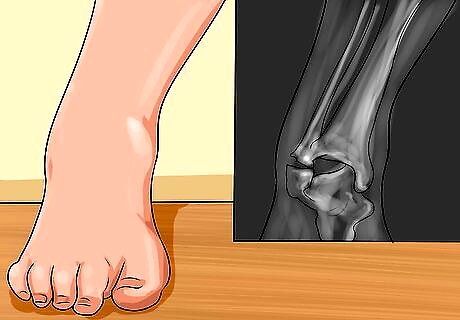
Recognize the signs of a fracture. A fracture is a bone injury that is especially common with high-speed ankle injuries in the healthy population or minor falling injuries in the elder population. The symptoms are often similar to a grade III sprain. A fracture will require X-rays and professional treatment. A fractured ankle will be very painful and unstable. A minor or hairline fracture may be identical in symptoms to a sprain, but if you suspect a hairline fracture use a split and walk on crutches. A popping sound at the moment of injury may be evidence of a fracture. An obvious foot or ankle deformity, such as your foot laying in an unusual position or angle, is definite evidence of a fracture or ankle joint dislocation.
Treating Ankle Sprains

Consult your doctor if the sprain is severe. If you see any evidence of a moderate to severe fracture or a grade III sprain, you must see a doctor. In other words, if you cannot walk (or experience significant difficulty doing so), have a numb feeling in the area, are suffering extreme pain, or heard a pop at the time of the injury, see a physician. You will need X-rays and a professional examination to determine treatment. Self-care is often adequate for a minor to moderate sprain. But, a sprain that doesn't heal properly may lead to ongoing pain or swelling. If your sprain has gotten worse or hasn't gotten better at all over a week then see your doctor.

Rest the ankle. You can use a self-care regimen referred to as RICE (Rest, Ice, Compression splinting, and Elevation). This is an acronym that stands for the four treatment actions. For a grade I to II sprain, RICE might possibly be all the treatment you need The first step is to rest the ankle. Avoid moving the ankle, and immobilize it if possible. If you have a ruler or a straight piece of hard material handy, you can fashion a splint that will protect the limb from any further injury. Try to splint your ankle so it's set in a normal anatomical position.
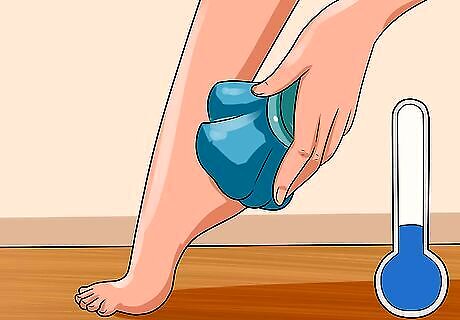
Ice the injury. Putting ice on the injury can reduce swelling and discomfort. Get something cold to put on the ankle as soon as you can. Place some ice in a bag gently on the joint. Cover it with a washcloth or towel to avoid possible frostbite on your skin. A bag of frozen peas also makes a good ice pack. Ice the injury for 15-20 minutes at a time, every 2-3 hours. Continue icing the injury in this way for 48 hours.
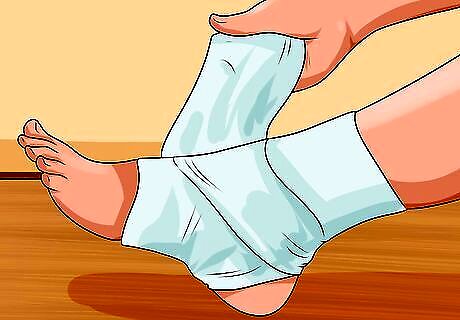
Compress the ankle. For a grade I sprain, compressing the injury with an elastic bandage can help provide stability and reduce the risk of another injury. Wrap the area with bandage using a "figure-eight" pattern around the ankle. Don't wrap it too tight, or you may worsen swelling. You should be able to get a finger between the bandage and your skin. If you believe you have a grade II or III sprain, don't use compression. with grade III's still go to a doctor as soon as possible
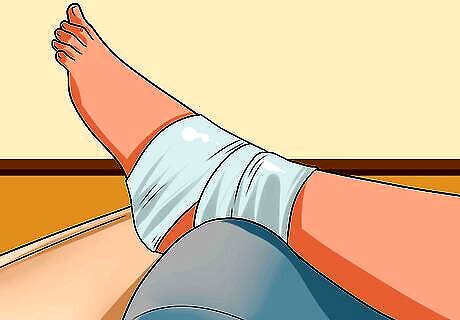
Elevate your foot. Elevate the limb above your heart. Place your foot up on two pillows. This will decrease blood flow to the area and allow the swelling to improve. Elevation will assist gravity in clearing the swelling, and help the pain.

Take medication. To help manage the pain and swelling, you can take NSAIDs (non-steroidal anti-inflammatory drugs). Common over-the-counter NSAIDs include ibuprofen (trademarked names include Motrin, Advil), naproxen (trademarked as Aleve), and aspirin. Acetaminophen (also called Paracetamol or trademarked Tylenol) is not an NSAID and does not manage inflammation, but it can help reduce pain. Take only as directed on the packaging, and don't take NSAIDs for pain for more than 10-14 days. Do not give aspirin to children under the age of 18 due to the risk of developing Reye syndrome. For a grade III sprain, your doctor may prescribe a narcotic to take for the first 48 hours.
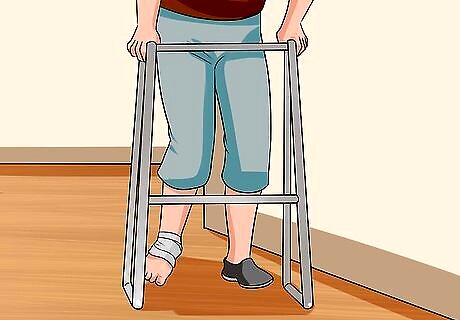
Use a walking aid or immobilizer. for a grade III sprain once they have taken care of it your doctor may suggest a medical device to help you move around and/or immobilize your ankle. For example: You may need crutches, a cane, or a walker. Your level of balance will determine which is best for your safety. , you may want to consider using a bandage or ankle brace to immobilize the ankle. In severe cases, an orthopedic surgeon may put your ankle in a rigid cast.




















Comments
0 comment